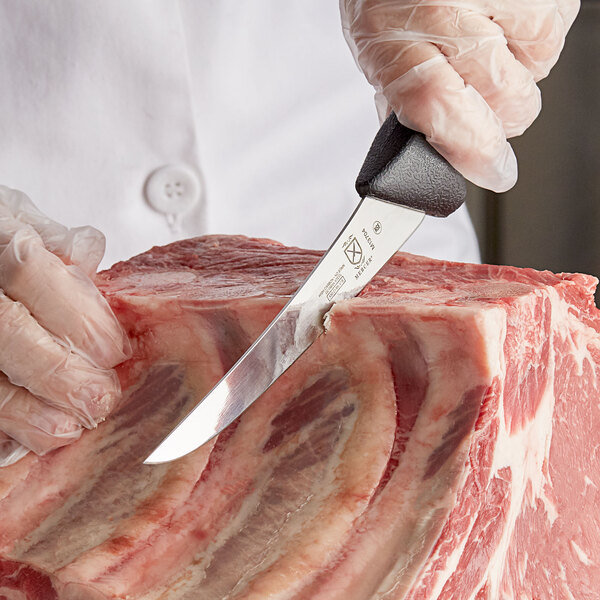A flexible boning knife is better for thinner meats and proteins with smaller bones, offering more dexterity, while a semi-flexible boning knife is ideal for deboning heavier bones without cutting into them.

Credit: www.webstaurantstore.com
Why Use A Flexible Boning Knife?
A flexible boning knife is designed for precise meat removal from bones, cutting through connective tissue, and separating meat from fat or joints. Its slightly flexible blade allows for maneuvering in small spaces, making it ideal for tasks such as deboning fish or chicken.
On the other hand, a stiff boning knife is better suited for working with long, sturdy bones, like those found in pork or beef. It can also serve multiple purposes, easily finding its way to the chopping board or a pie pan.
The difference between semi-stiff and semi-flexible lies in their rigidity, with semi-flexible blades bending more easily for delicate tasks, while semi-stiff blades are more rigid and better suited for heavier cutting tasks. The flexibility of a boning knife is crucial for making clean cuts with consistent edges.
The Difference Between Semi-Stiff And Semi-Flexible
A semi-flexible boning knife is better suited for delicate tasks like deboning fish or chicken as its blade bends more easily. On the other hand, a semi-stiff blade is more rigid and is ideal for heavier cutting tasks, such as working with beef or pork.
The flexibility of a boning knife allows for easier trimming of bone and fat. When choosing between a flexible and semi-stiff boning knife, consider the type of meat you will be working with and the level of precision required. Both types of knives have their advantages and can be used for various purposes, so it’s important to select the one that best suits your needs.
Benefits Of Using A Flexible Boning Knife
If you’re wondering whether a flexible or semi-flexible boning knife is better, consider the benefits of using a flexible knife. Firstly, it allows for clean cuts with consistent edges, ensuring that your meat looks and cooks perfectly. Additionally, a flexible boning knife is ideal for slicing through tough surfaces, making it easier to work with cuts of meat that have a lot of connective tissue or ligaments.
Moreover, the flexibility of the blade allows you to follow along heavier bones during the deboning process without cutting into them. This is particularly useful when working with thicker cuts of meat or larger bones. Overall, a flexible boning knife offers versatility and precision when it comes to tackling various types of meat and bones.
Frequently Asked Questions
Should A Boning Knife Be Flexible Or Stiff?
A boning knife can be stiff or flexible. Stiff knives are best for working with sturdy bones like pork or beef. Flexible knives are suited for maneuvering in small spaces like between bones.
Why Use A Flexible Boning Knife?
A flexible boning knife is used for precisely removing meat from bones, cutting through connective tissue, and separating meat from fat or joints. It allows for maneuverability in small spaces and is thicker and sturdier than a fillet knife.
What Is The Difference Between Semi Stiff And Semi Flexible?
The difference between semi stiff and semi flexible is that a semi stiff blade is more rigid and better suited for heavier cutting tasks, such as working with beef or pork. On the other hand, a semi flexible blade bends more easily and is ideal for delicate tasks like deboning fish or chicken.
Should Knives Be Flexible?
A boning knife can be flexible or stiff. A stiff knife is better for working with sturdy bones and can be used for multiple purposes. A flexible knife is ideal for maneuvering in small spaces.
Is A Flexible Boning Knife Better For Deboning Meat?
A flexible boning knife is better for deboning meat, allowing for more maneuverability around bones and joints.
Can A Stiff Boning Knife Be Used For Multiple Purposes?
Yes, a stiff boning knife can be used for multiple purposes, such as chopping or slicing, in addition to deboning meat.
Why Should I Use A Flexible Boning Knife?
A flexible boning knife is designed specifically for removing meat from bones, cutting through connective tissues, and separating meat from fat or joints.
What Tasks Is A Semi-Stiff Blade Better Suited For?
A semi-stiff blade is better suited for heavier cutting tasks, such as working with beef, pork, and most game.
Should I Choose A Flexible Or Stiff Boning Knife For Working With Long, Sturdy Bones?
If you are working with long, sturdy bones like those found in pork or beef, it is best to choose a stiff boning knife.
What Is The Advantage Of A Semi-Flexible Boning Knife?
A semi-flexible boning knife offers the advantage of being able to follow along heavier bones without cutting into them.
Conclusion
To determine whether a flexible or semi-flexible boning knife is better, it’s essential to consider your specific needs and preferences. A stiff knife is ideal for working with sturdy bones, such as those found in beef or pork, and can also be versatile for multiple purposes.
On the other hand, a flexible boning knife offers more maneuverability in tight spaces, making it perfect for delicate tasks like deboning fish or chicken. Additionally, a semi-flexible blade strikes a balance between rigidity and flexibility, making it suitable for heavier cutting tasks like beef or game.
Ultimately, the choice between a flexible and semi-flexible boning knife depends on the type of meat and bones you typically work with, as well as your personal comfort and preference. Consider the specific tasks you’ll be undertaking in the kitchen and choose the boning knife that best suits your needs.
Happy boning!

This is Kristina, a passionate content writer, copywriter, and bookworm. Always dedicated to providing informative and accurate product reviews for enjoyable shopping. In my free time, I love spending time in nature and with animals and doing yoga.
